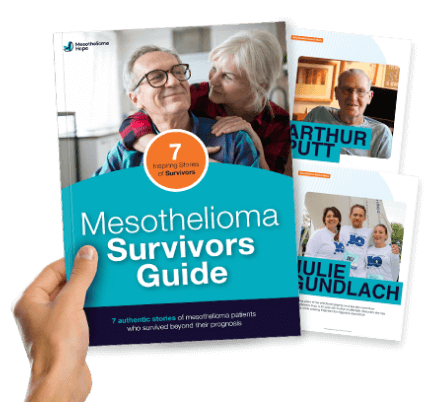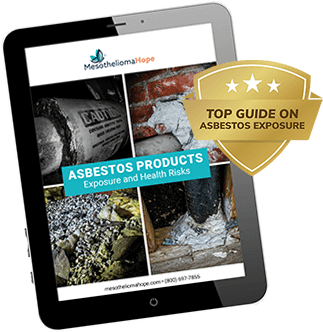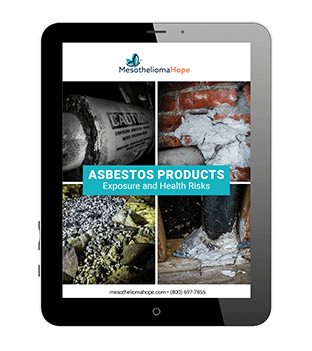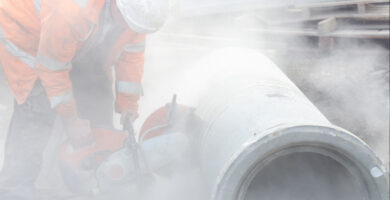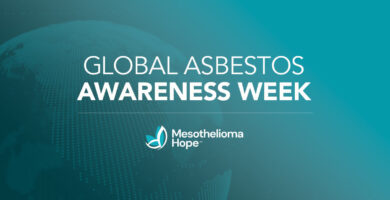Many people have heard about the dangers of asbestos and how it causes mesothelioma, a rare and aggressive cancer that develops in the lining of the lungs or abdomen.
However, some people may not know that asbestos hasn’t been banned and that people are still at risk of dangerous health impacts from the carcinogenic mineral. Thankfully, it’s not all bad news, as advances in mesothelioma treatment are helping people live longer and with fewer symptoms.
Learn some common myths and misconceptions about asbestos and mesothelioma below.
Myth 1: Only People Who Work Directly With Asbestos Are At Risk of Mesothelioma
Indirect contact with asbestos is every bit as dangerous as handling the material directly. This is because there is no safe level of asbestos exposure, and even one fiber can increase someone’s risk of mesothelioma.
When asbestos fibers are released, they can linger in the air or settle in clothing, hair, water supplies, and food. These fibers pose just as much a threat to human health as the products that they came from.
For example, if a blue-collar worker comes home with asbestos fibers on their clothes, their spouse or children could unknowingly breathe in these fibers and develop mesothelioma decades later.
Family members could have also been exposed to asbestos by:
- Living in a home built with asbestos products
- Visiting a family member on a job site
- Washing clothes covered in asbestos dust
There is also an environmental risk associated with asbestos. In areas where asbestos is mined, the groundwater, soil, and air can contain high concentrations of asbestos fibers.
Find more information about where asbestos is found and the risks of the dangerous carcinogen in our Free Asbestos Products Guide.
Myth 2: Asbestos Is Banned and No Longer Used
Unfortunately, asbestos is still not banned in the U.S., even though over 50 nations worldwide have outlawed the mineral. Asbestos products are still used in chemical manufacturing processes, putting workers at work of exposure.
Additionally, over 3,000 consumer goods made with asbestos products may still lurk in homes and workplaces built before the early 1980s.
Asbestos can be found in:
- Ceiling and floor tiles
- Cement
- Electrical and plumbing systems
- Insulation
- Plaster
- Siding
- Other materials
If asbestos-containing products are damaged or disturbed, asbestos fibers can become airborne, putting anyone nearby at risk of mesothelioma and other health problems.
Myth 3: Mesothelioma Only Affects the Elderly
In most cases, it takes 10 to 50 years for mesothelioma symptoms to appear after asbestos fibers enter the body. As a result, mesothelioma is rarely diagnosed in people younger than 50.
However, anyone who has been exposed to asbestos is at risk, including:
- Teens: To date, the youngest person who has died from mesothelioma is 18-year-old Sophie Ellis from England, who was diagnosed at 13.
- Young adults: There have been cases where otherwise healthy people in their 20s or 30s have developed mesothelioma. One mesothelioma survivor, Julie Gundlach, was diagnosed at only 35 years old, but she is still fighting more than 17 years after her diagnosis.
Myth 4: Mesothelioma Treatment Isn’t Worth It
Since mesothelioma is aggressive, many people assume treatment won’t be worth it. However, within the last two decades, treatment advances have greatly improved life expectancy and overall survival.
“Patients assume when they have the disease that they can’t survive and can’t live with the disease, even though many of our patients are walking around living relatively normal lives.”
Mesothelioma specialists often combine surgery, chemotherapy, immunotherapy, and other emerging treatments to get the best results.
Even those diagnosed in advanced stages are starting to see promising results from treatment. For example, John Stahl was diagnosed with stage 4 mesothelioma, the most advanced stage of this cancer that has an average life expectancy of only 1 year. Thanks to chemotherapy, he has survived for over 4 years.
Read more survivor stories and learn how they beat the odds in our Free Mesothelioma Survivors Guide.
Myth 5: Mesothelioma Is Just A Different Name for Lung Cancer
Symptoms of pleural mesothelioma, the type of mesothelioma that affects the lungs, can overlap with those of lung cancer. However, these two cancers are not the same.
Mesothelioma is unique from lung cancer in the following ways:
- Pleural mesothelioma starts in the thin tissue surrounding the lungs called the pleura rather than inside the lungs like lung cancer.
- Mesothelioma tumors develop in a different way. Lung cancer tumors develop in lumps, whereas mesothelioma tumors spread in sheets across the lung lining and require unique treatment practices.
- The only known cause of mesothelioma is asbestos exposure, while lung cancer has several causes, including smoking, family history, and asbestos.
- Mesothelioma is very rare compared to lung cancer. Fewer than 3,000 cases of mesothelioma are diagnosed each year, compared to over 230,000 cases of lung cancer.
A mesothelioma misdiagnosis can make it difficult to get the right treatment, so it’s important that you are accurately diagnosed the first time.
Myth 6: There Is Only One Kind of Asbestos
Most people talk about asbestos as if it were one material, but in fact, the term applies to six different silicate minerals.
Asbestos can be divided into two groups: serpentine and amphibole.
- Serpentine asbestos has a layered or sheet-like structure and has historically been the most commonly used type of asbestos in the United States. Chrysotile is the only mineral in the serpentine group. Today, some manufacturers will try to confuse buyers by listing chrysotile as an ingredient instead of asbestos in their products.
- Amphibole asbestos includes amosite, crocidolite, anthophyllite, tremolite, and actinolite. Of these, amosite and crocidolite were the most widely used forms. When viewed under a microscope, these minerals’ fibers are sharp and needle-like.
Lawyers who represent asbestos companies sometimes claim that certain types of asbestos are not harmful. However, this is not true. Any type of asbestos can lead to mesothelioma if the fibers are inhaled or ingested.
Myth 7: Asbestos Workers Knew the Risks But Ignored Them
The exact opposite is true. Those who worked with asbestos materials — and the general public — did not know the dangers until it was too late.
This is because the manufacturers of asbestos products hid the dangers of the mineral. Since asbestos was cheap to extract and resisted fire, water, and sound, corporations could make millions selling asbestos-containing products at the expense of workers’ lives.
It has been documented that when employees expressed concern about the great clouds of asbestos dust that surrounded them in the workplace, their supervisors lied to them about the health risks.
When internal studies concluded that workers were falling prey to respiratory conditions at a much greater rate than the average population, executives hid the studies.
It was not until the early 1980s that the health risks of asbestos reached national attention. By then, greedy asbestos companies had profited off the mineral for over 50 years.
Learn more about the history of asbestos, the products it’s used in, and more in our Free Asbestos Products Guide.
Myth 8: Asbestos Should Be Removed Immediately If It Is Found
There are times when it is better to leave asbestos materials in place to avoid releasing fibers into the air.
According to the Environmental Protection Agency (EPA), asbestos-containing materials are classified as either friable or non-friable. If a product is friable, it can be crushed by very slight pressure (like if someone puts their hand on it).
Asbestos products can become friable if they’re damaged or naturally weaken over time. Friable asbestos products can release microscopic fibers into the air and put anyone nearby at risk.
Today, it is recommended that people leave older asbestos products intact if they are not damaged and talk with professionals about when it will be best to remove them
Myth 9: “I’ll Be Fine If I Wear a Mask”
While a respirator mask should always be worn around asbestos, never handle or remove any asbestos-containing materials yourself.
Anyone who practices asbestos abatement, which is the removal of asbestos-containing materials, needs to be properly trained and licensed. In some states, it is illegal to remove asbestos without a license because of the potential health hazards.
Asbestos fibers can remain airborne for hours. Amateur removal projects can put you, your family, and your neighbors at risk of mesothelioma and other asbestos-related diseases.
A removal specialist will wear a respirator and other protective clothing and also take steps to properly dispose of any asbestos-containing materials to prevent contamination.
Myth 10: The Dangers of Asbestos Have Been Exaggerated by Lawyers
While it is true that asbestos lawsuits have become one of the biggest legal battles in the United States today, the dangers of asbestos have been well-documented by the scientific and medical communities.
Hundreds of studies have reported how asbestos leads to mesothelioma and other diseases in humans. These studies date back to the 1930s when the health risks first became known.
However, the manufacturers of asbestos products knew they could make millions from their products. They hid the deadly truth about asbestos for decades until the public finally caught on.
Get the Facts and Take Action
As with any disease, knowledge is power. The more you know about an illness, the better prepared you will be to combat it.
Anyone who may have experienced asbestos exposure in the past is strongly encouraged to tell their doctor. Additionally, they should watch for potential symptoms of mesothelioma.
Common mesothelioma symptoms include:
- Fatigue
- Nausea
- Pain in the stomach, chest, back, or ribs
- Persistent and/or bloody cough
- Shortness of breath
- Swelling of the face or neck
By knowing the facts and staying alert, those at risk of developing mesothelioma can take action and get the help they need.
If you or a loved one have been diagnosed with mesothelioma, our Patient Advocacy Team can answer your questions and connect you with free medical and legal resources. Call (866) 608-8933 now or fill out our contact form to learn more.





